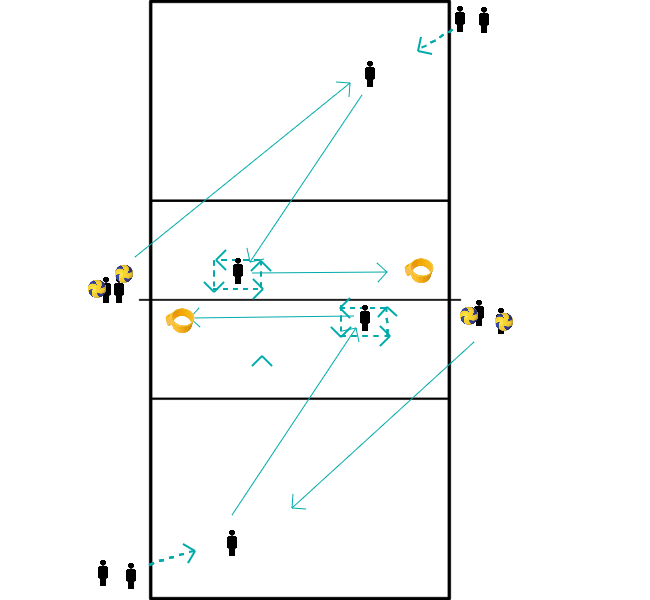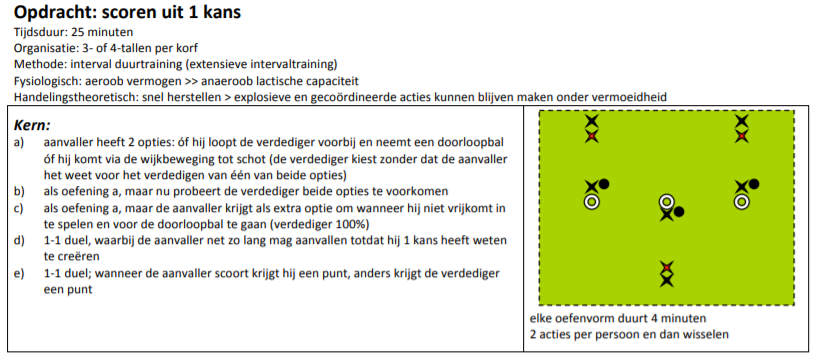Korfball drills
- You start with 3 players at a pole.
- Number 1 runs aside, gets the ball and shoots, then the one under the post (player 3) catches the ball.
- At that moment player 2 has to cut in front of player 1 and run for the second chance.
- Continue this way until one of the two has made three.
- The loser changes places with the one under the basket, a winner may stay at the basket a maximum of 3 times.
- 1 loafer who can't have the ball, no tapping.
- Throwing good balls.
- Not caught is fault of the thrower.
- Tapping the ball is enough for the batsman.
- Roll the dice
- How many dots do you see?
- This is how many steps you make from the basket and from there you make a distance shot.
- 2nd variant:
- Throw the dice
- How many dots do you see?
- How many walk-throughs or penalty shots or small chances can you make?
- Set out a course for relay where the children have to pass the ball on, so with
- pawns,
- running ladders,
- benches
- etc.
- One person runs the course with the ball and then passes the ball to the next person.
- 2 or 3 teams means 2x the course.
- Three teams at a basket. 1 shooter, 2 catchers who stand about 3 metres on either side of the basket facing the shooter.
- As soon as the shooter has released the ball, they may move towards the basket to catch it.
- The first player to catch the ball correctly may be the shooter.
- Quick turn.
- If there is a person who does not catch the ball first, give that person extra guidance to catch it correctly.
- Pionnon at 2.5, 4 and 6 meter, first pawn hits 1 point, 3 and 5 points on the next one.
- Shooter may choose where to shoot from. first 40 points
- Passing balls from every pawn, always behind the post. Order of scoring 1-2-3-2-1
- 1 pawn on the side, 3 meter next to the other 3. shoot from the move and hit the first 2 pawns, then change.
- You have the team form a circle around the trainer.
- They have to keep moving; when they are called left, they turn left and sprint away.
- When the call is to the right, they turn right and sprint away
- You have an attacker at 5 meters in front of the basket who is going to shoot on the move.
- Underneath the basket there is a declarator and a rebounder.
- After having played the ball, the attacker leaves the room.
- The attacker shoots as soon as he has the ball and runs immediately to catch it himself.
- The attacker only has a point when he catches the ball himself.
- The rebounder has a point when he catches the ball.
In teams of four, two attackers and two defenders.
- Player 1 with the ball throws it to player 2.
- Player 1 comes next to player 2
- Player 2 throws the ball back and runs deep
- Player 1 throws the ball to player 2
- Player 1 goes right in for catch and player 2 shoots.
- Two teams.
- Setters on 2/3 on a mat.
- Basket on both sides on 4.
- High speed ball over the net, pass to setter, setter plays towards the basket.
- The setter is not allowed to leave the mat!
- Hitting the basket is 1 point, ball in basket is 3 points.
- Who is first at 25 wins!

In short: exercise with the emphasis on turning away from the opponent.
Organisation: Each team of five or four players has a ball and an area of about 20 by 20 metres. The players are numbered.
a ) Number 1 is attacking, number 2 is defending and numbers 3, 4 and 5 are playing together with the attacking player. Everybody can move freely through the area. The attacker always gets the ball back from numbers 3, 4 and 5. The defender's task is to intercept the ball. Can the attacker manage not to lose the ball a single time? The ball may not fall on the ground either! After about 30 seconds the players change tasks: number 3 attacks, number 4 defends, etc. until everyone has been attacker and defender once.
If necessary, extend the task next time:
b ) As a., but give the instruction that the attacker always has to turn away from her defender: that way she can both pass and receive the ball back easily. I call this: 'cutting and turning', others call it 'keeping your opponent on your back'.
c ) As a., but now the team-mates 3, 4 and 5 stand still in a triangle with a distance of about 15 metres. This makes it more difficult for the attacker.
d ) It becomes even more difficult if the attacker is instructed to pass the ball to the other players in a fixed order. She now has to run in circles, so that the defender knows exactly where the ball will go, or where the attacker wants to run to. Many balls will now be intercepted, or at least touched.
e ) Again part c. Show that the attacker has an easier time of it now because of the freedom of choice By turning away from her opponent, she creates a sea of space for herself!








